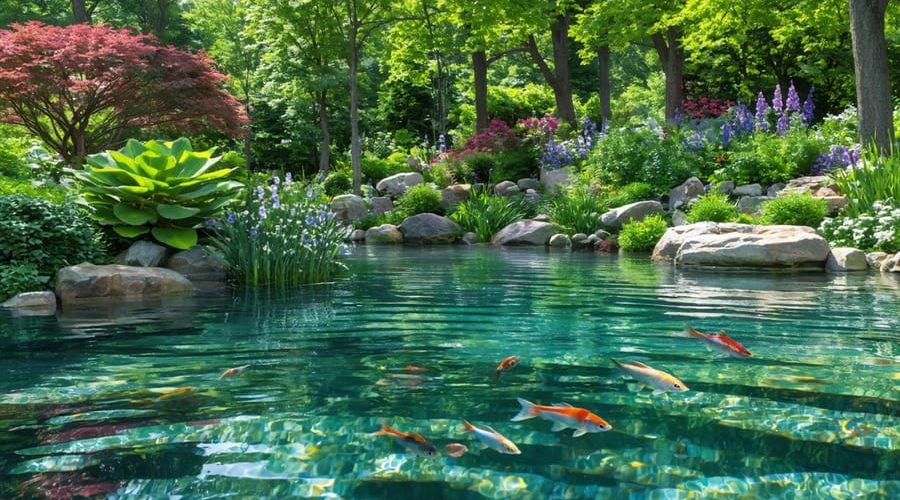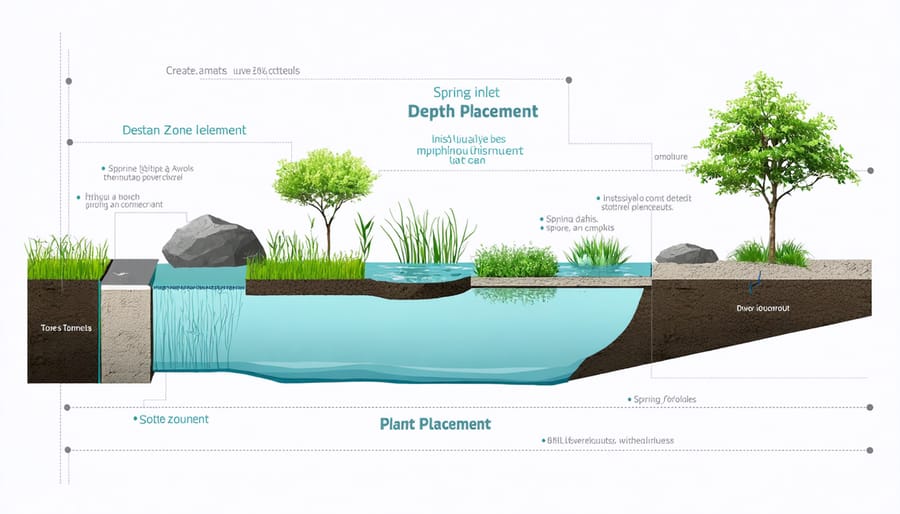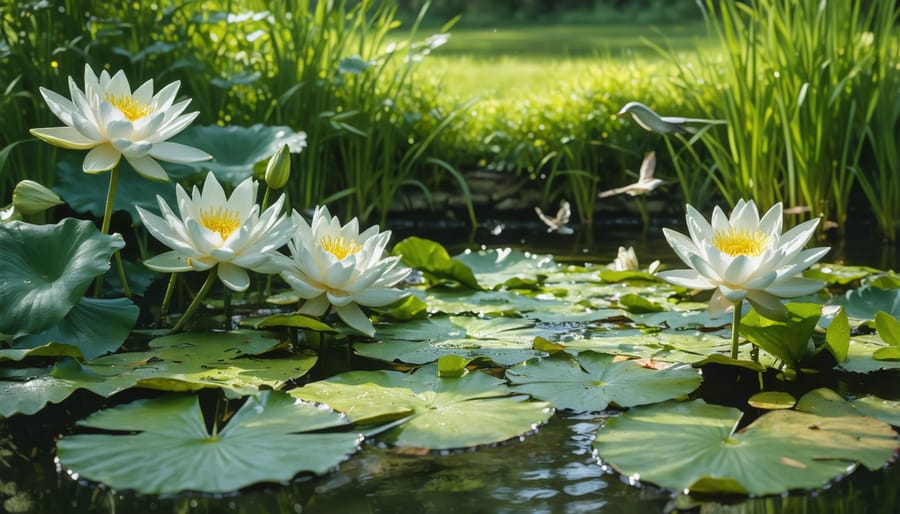
Transform Your Garden with a Spring-Fed Pond (Natural Beauty Made Easy)
Spring-fed ponds stand as nature’s masterpiece of sustainable water management, offering a self-maintaining ecosystem that transforms any landscape into a thriving aquatic haven. Unlike artificial ponds that require constant filling, these natural spring water features tap into underground aquifers, providing crystal-clear water year-round while supporting diverse wildlife and vegetation.
The continuous flow of fresh groundwater naturally regulates temperature, maintains optimal oxygen levels, and prevents common issues like algae overgrowth and stagnation. This perfect balance creates an ideal environment for native fish species and aquatic plants, while simultaneously serving as a sustainable water source for irrigation and recreational activities.
For property owners fortunate enough to have natural springs, these ponds represent not just a beautiful landscape feature, but a valuable resource that enhances both environmental sustainability and property value. Whether you’re planning to create a new spring-fed pond or optimize an existing one, understanding the delicate ecosystem these water features support is crucial for maintaining their natural beauty and ecological benefits.
What Makes Spring-Fed Ponds Special

Natural Water Quality Benefits
One of the most appealing aspects of a spring-fed pond is its exceptional water quality. Unlike artificially filled ponds, spring-fed ponds receive a constant supply of fresh, naturally filtered groundwater that’s rich in beneficial minerals. This continuous flow helps maintain crystal-clear water that’s free from many common pond problems like algae blooms and stagnation.
The natural mineral content in spring water typically includes calcium, magnesium, and other trace elements that support healthy aquatic life. These minerals create ideal conditions for fish and plants while helping to maintain a balanced ecosystem. You’ll often notice that spring-fed ponds have less trouble with pH fluctuations, making them more stable environments for pond life.
Temperature stability is another fantastic benefit of spring-fed ponds. The groundwater maintains a fairly consistent temperature year-round, usually between 50-60°F (10-15°C). This helps prevent dramatic temperature swings that can stress fish and other aquatic creatures. During summer, the cool spring water keeps the pond from overheating, while in winter, the relatively warm groundwater can help prevent complete freezing, creating safe zones for fish.
Year-Round Water Supply
One of the most appealing aspects of a spring-fed pond is its reliable, year-round water supply. Unlike traditional ponds that rely on rainfall or manual filling, spring-fed ponds maintain a constant water level through natural groundwater flow. This continuous supply makes them an excellent example of sustainable water management in your backyard paradise.
The steady inflow of fresh spring water helps maintain optimal water quality naturally, reducing the need for frequent chemical treatments or intensive maintenance. Since the water is constantly moving and being renewed, there’s less likelihood of algae blooms or stagnant conditions developing. This natural circulation also helps maintain consistent oxygen levels, creating a healthier environment for fish and aquatic plants.
During dry spells and drought conditions, spring-fed ponds continue to provide a reliable water source, making them particularly valuable for wildlife and garden irrigation. The consistent water level also protects pond liners and equipment from damage that can occur with fluctuating water levels, ultimately extending the life of your pond installation.
Planning Your Spring-Fed Pond
Site Selection and Assessment
Finding the perfect location for your spring-fed pond starts with identifying potential natural springs on your property. Look for areas where water naturally seeps from the ground, creating consistently damp or soggy spots. These areas often feature water-loving plants and may remain green even during dry spells.
To evaluate a spring source, observe it throughout different seasons. A reliable spring should flow consistently, though the rate may vary. Dig a small test hole near the seepage area and monitor how quickly it fills with water. Clear water that maintains a steady temperature year-round is typically indicative of a good spring source.
Consider conducting a simple flow rate test by measuring how much water the spring produces over 24 hours. This helps determine if the spring can sustain your desired pond size. You’ll also want to test the water quality, checking for pH levels, mineral content, and potential contaminants.
The surrounding landscape plays a crucial role too. Ideal sites have a natural depression or gentle slope that can be enhanced to create your pond. Avoid areas near septic systems, animal pastures, or chemical storage facilities. Also, check local regulations regarding water rights and pond construction before proceeding.
Take note of existing vegetation and wildlife, as these can indicate the health of the water source and help you plan for your pond’s ecosystem.
Design Considerations
When designing a spring-fed pond, working with the natural water source is key to creating a sustainable and beautiful water feature. Start by identifying the spring’s location and flow rate, as this will determine your pond’s layout and size. Position the deepest part of your pond near the spring outlet to maintain cooler water temperatures and create natural circulation.
For optimal function, aim for a depth of at least 6-8 feet in the main basin, with gradual slopes leading to shallower edges. This depth profile helps manage temperature fluctuations and provides different zones for aquatic life. Include a series of shelves or terraces around the edges at various depths (6″, 12″, and 24″) to accommodate different types of water plants.
Consider incorporating natural filtration zones using gravel beds and aquatic plants near the spring’s entry point. This helps maintain water clarity while creating a more natural ecosystem. Design the overflow area carefully, ensuring proper drainage during periods of heavy spring flow to prevent erosion.
Add features like flat rocks around the edges for easy maintenance access and wildlife viewing. A beach-style entry point on one side makes it easier to maintain the pond and creates a natural-looking transition from land to water. Remember to leave some areas shallow for wildlife access and to include hiding spots like submerged logs or rock formations for fish.

Legal and Environmental Factors
Before starting any spring-fed pond project, it’s essential to research and comply with local regulations. Most areas require permits for excavation and water usage, especially when tapping into natural springs. Contact your local water authority or environmental agency to understand specific requirements and restrictions.
Environmental impact assessments may be necessary, particularly if your pond connects to existing waterways or affects local wildlife habitats. Consider how your pond might influence groundwater levels and neighboring properties. Many regions have strict guidelines about maintaining natural water flow and protecting aquatic ecosystems.
Wildlife protection is another crucial consideration. Spring-fed ponds often become habitats for various species, and you may need to follow specific guidelines to protect endangered species or manage invasive ones. Some areas require buffer zones or specific plant species to maintain ecological balance.
Water rights are particularly important when dealing with springs. In many locations, you don’t automatically own the rights to spring water on your property. Verify your water rights and understand any limitations on water usage or modification of natural springs.
Remember to factor in regular water quality testing and monitoring requirements. Some jurisdictions mandate periodic testing and reporting, especially if your pond connects to other water sources or serves as wildlife habitat. Keep detailed records of all permits, tests, and modifications to ensure ongoing compliance.
Spring Revival Maintenance
Spring Cleaning Essentials
As winter fades away, your spring-fed pond needs some tender loving care to thrive in the warmer months ahead. Start with a thorough assessment of your pond’s condition – this is a crucial part of seasonal pond maintenance that sets the stage for a healthy ecosystem throughout the year.
Begin by carefully removing any debris that’s accumulated over winter, including fallen leaves and dead plant material. Pay special attention to the spring source area, ensuring it’s clear of obstructions that might affect water flow. Test your water quality, checking pH levels and dissolved oxygen content, which are particularly important as aquatic life becomes more active.
Inspect your pond’s edges for any erosion that might have occurred during winter, and shore up any weakened areas with natural materials that match your pond’s aesthetic. Trim back any overgrown vegetation around the spring source, but be careful not to disturb the natural flow patterns that make your pond unique.
If you have a filtration system, now’s the time to clean or replace filters and check that all mechanical components are working properly. Don’t forget to examine any pipework or overflow systems – spring rains can put extra pressure on these elements.
Remember to introduce beneficial bacteria to help jump-start your pond’s biological filtration system, especially important after the dormant winter period. This helps maintain crystal-clear water and a balanced ecosystem as temperatures rise.
Plant Selection and Care
Selecting the right plants for your spring-fed pond is crucial for creating a thriving ecosystem. Native aquatic plants are particularly well-suited as they’re adapted to local conditions and help maintain water quality. Consider including emergent plants like cattails and rushes along the pond’s edges to create natural filtration and wildlife habitat.
For the deeper areas, submerged plants such as hornwort and water lilies work wonderfully. These plants not only add beauty but also provide essential oxygen and shelter for pond life. When planning your water garden preparation, divide your pond into planting zones based on water depth.
Maintain your pond plants by regularly trimming dead foliage and dividing overgrown specimens in spring. For water lilies, fertilize them every six weeks during the growing season using aquatic plant tablets. Watch for invasive species and remove them promptly to prevent them from overtaking your pond.
Remember to keep about 60% of your pond’s surface free from floating plants to maintain proper oxygen exchange. For best results, introduce plants gradually and observe how they adapt to your specific pond conditions. This patient approach helps ensure a balanced and beautiful aquatic garden that complements your spring-fed pond’s natural characteristics.

Wildlife Management
A spring-fed pond offers a perfect habitat for various beneficial wildlife species, enriching your outdoor space with natural beauty and ecological balance. To attract desirable wildlife, start by planting native aquatic vegetation around the pond’s edges and in shallow areas. These plants provide shelter, nesting sites, and food for birds, amphibians, and beneficial insects.
Consider adding partially submerged logs or rocks near the shoreline to create basking spots for turtles and resting areas for birds. Installing birdhouses and feeders nearby can attract songbirds, while shallow areas with gradual slopes make perfect access points for wildlife to safely enter and exit the water.
However, it’s important to maintain a balance. While you want to welcome beneficial wildlife, you’ll need to manage unwanted visitors like mosquitoes. Adding mosquito-eating fish such as minnows or gambusia can help control these pests naturally. You might also consider introducing freshwater mussels or snails to help keep the water clean.
To protect your pond’s ecosystem, avoid using chemical pesticides or herbicides near the water. Instead, rely on natural predator-prey relationships to maintain balance. During different seasons, you may notice changes in wildlife activity – this is normal and helps maintain the pond’s health year-round.
Remember to provide some deeper areas in your pond (at least 3-4 feet) to give wildlife a safe place to retreat during extreme weather conditions or when predators are nearby.
Common Challenges and Solutions
While spring-fed ponds are natural wonders, they come with their own set of challenges. One common issue is fluctuating water levels, especially during dry seasons when spring flow may decrease. To address this, consider installing a backup water source or deepening certain areas of the pond to maintain stable water levels.
Excess sediment buildup is another frequent concern, as springs can carry minerals and debris. Regular monitoring and occasional dredging help maintain proper depth and water quality. Installing sediment traps near the spring source can also reduce accumulation over time.
Algae growth often troubles pond owners, particularly when nutrient levels are high. Adding beneficial aquatic plants that compete with algae for nutrients can help maintain balance. Incorporating proper aeration through fountains or diffusers also helps prevent algae overgrowth.
Temperature regulation can be challenging, as spring water is typically cooler than surface water. This can affect fish and plant life. Creating varying depths in your pond provides temperature zones that accommodate different species’ needs.
Erosion around spring outlets may occur over time. Stabilizing these areas with rocks and appropriate vegetation helps prevent soil loss and maintains the pond’s structure. Regular inspection of banks and spring sources allows for early detection and treatment of erosion issues.
Wildlife management presents another challenge, as spring-fed ponds attract various creatures. While this biodiversity is generally beneficial, installing protective measures like fencing or netting can help control unwanted visitors while maintaining the pond’s natural appeal.
Spring-fed ponds offer a sustainable, low-maintenance water feature that brings endless beauty and tranquility to any property. With their natural filtration, consistent water supply, and ability to support diverse aquatic life, these ponds are truly a gift from nature. Whether you’re looking to create a serene retreat, establish a thriving ecosystem, or add value to your property, a spring-fed pond delivers on all fronts. By working with the natural water source and implementing proper maintenance practices, you can enjoy crystal-clear water and healthy aquatic life year-round. Consider incorporating this remarkable water feature into your landscape – it’s an investment in both your property’s beauty and the environment that will reward you for years to come.
